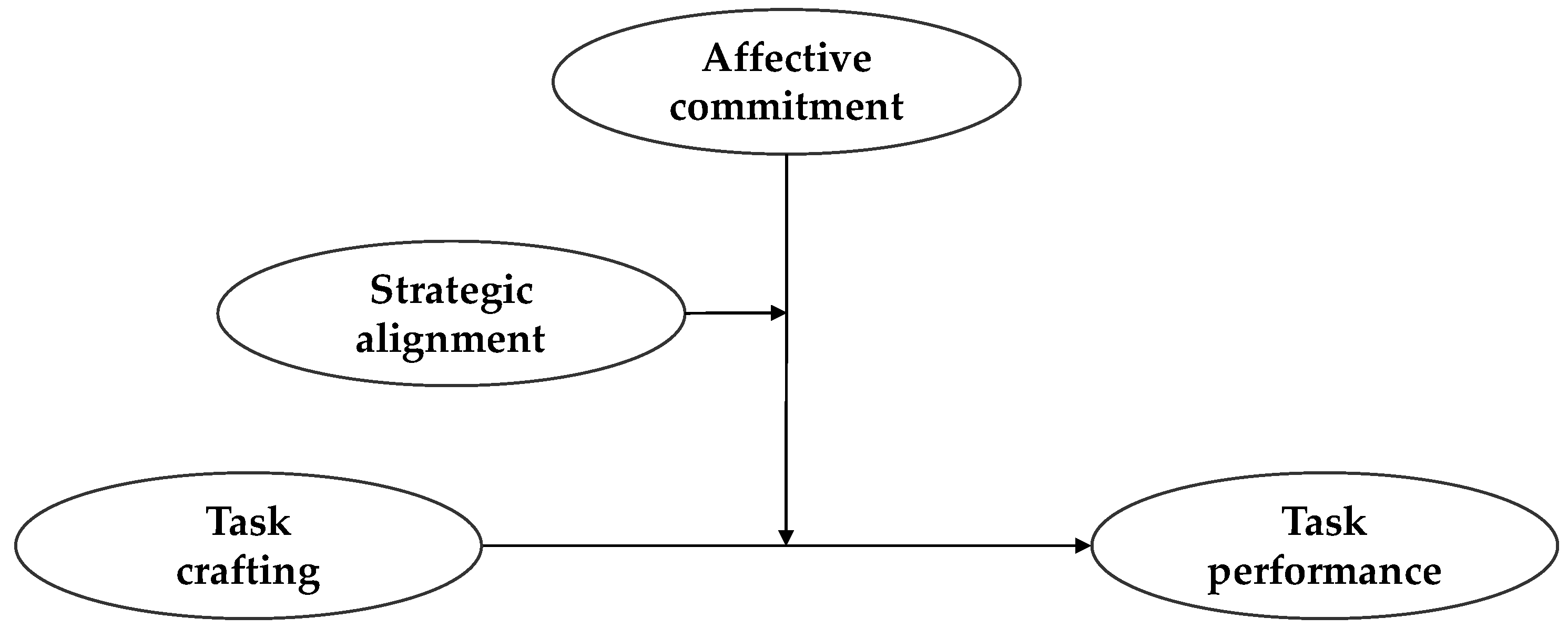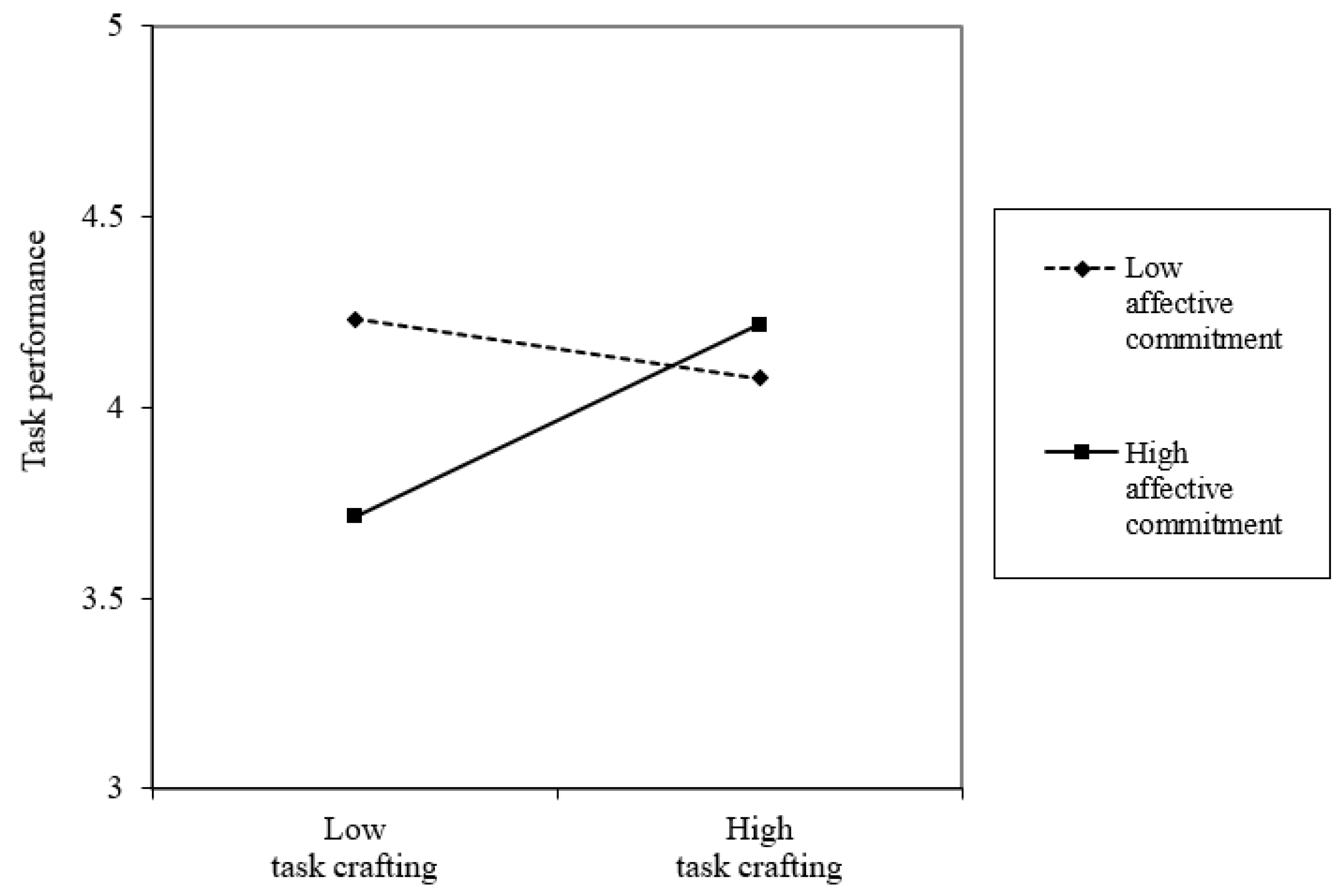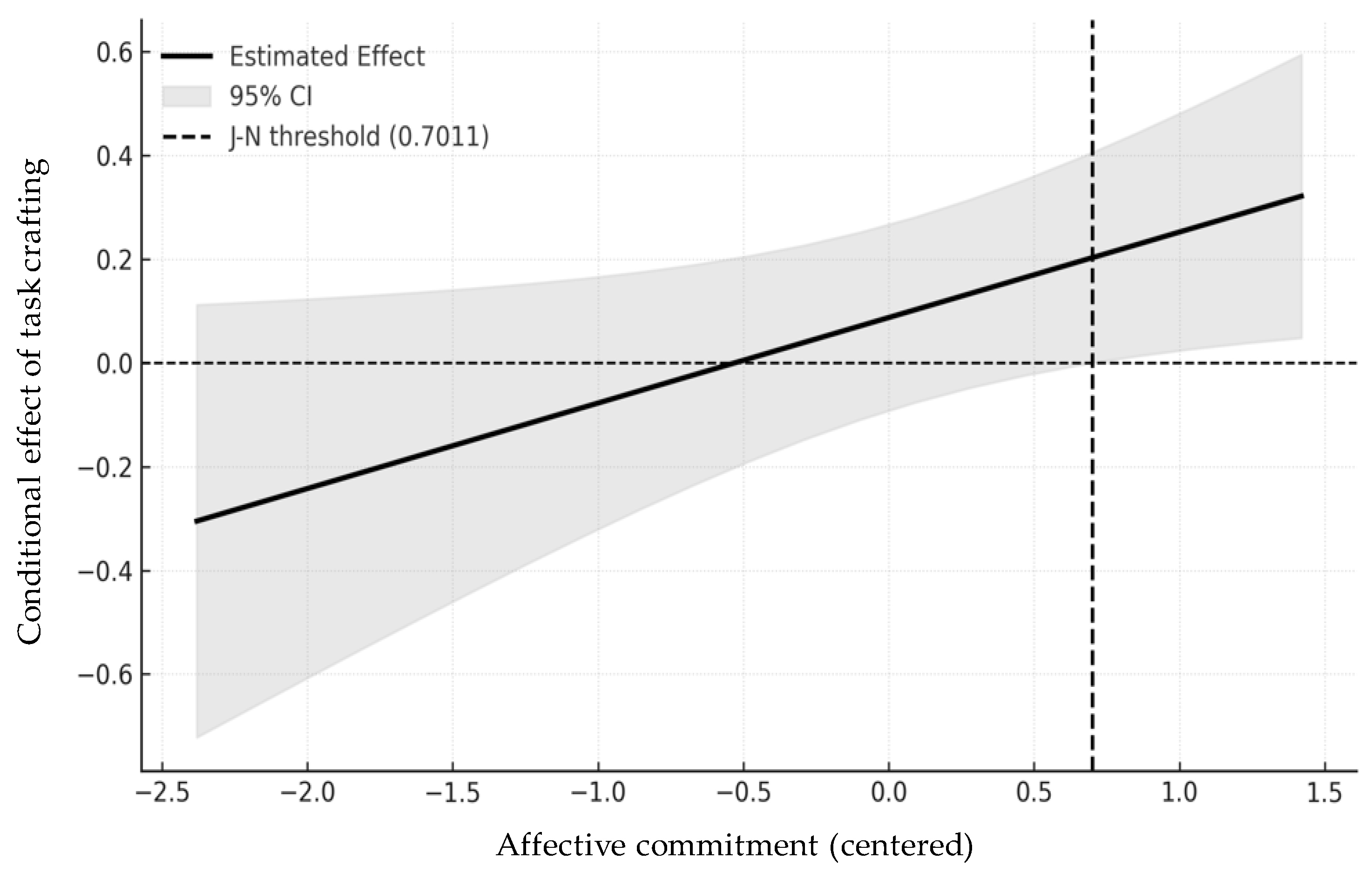What Turns Task Crafters into High Performers? Affective Commitment and Strategic Alignment as Critical Levers
Abstract
1. Introduction
2. Theoretical Framework and Hypothesis Development
2.1. Theoretical Framework
2.2. Affective Commitment as a First Lever
2.3. Strategic Alignment as a Second Lever
3. Methodology
3.1. Sample and Data Collection
3.2. Measures
3.3. Analytical Apporach
4. Results
4.1. Reliability and Validity Testing
4.2. Descriptive Statistics and Correlations
4.3. Hypothesis Testing
5. Discussions
5.1. Theoretical Contributions
5.2. Practical Implications
5.3. Limitations and Future Research Directions
6. Conclusions
Author Contributions
Funding
Institutional Review Board Statement
Informed Consent Statement
Data Availability Statement
Conflicts of Interest
References
- Aiken, L. S., & West, S. G. (1991). Multiple regression: Testing and interpreting interactions. Sage. [Google Scholar]
- Becker, T. E. (2005). Potential problems in the statistical control of variables in organizational research: A qualitative analysis with recommendations. Organizational Research Methods, 8(3), 274–289. [Google Scholar] [CrossRef]
- Biggs, A., Brough, P., & Barbour, J. P. (2014). Strategic alignment with organizational priorities and work engagement: A multi-wave analysis. Journal of Organizational Behavior, 35(3), 301–317. [Google Scholar] [CrossRef]
- Bizzi, L. (2017). Network characteristics: When an individual’s job crafting depends on the jobs of others. Human Relations, 70(4), 436–460. [Google Scholar] [CrossRef]
- Bliese, P. D. (2000). Within-group agreement, non-independence, and reliability: Implications for data aggregation and analysis. In K. J. Klein, & S. W. J. Kozlowski (Eds.), Multilevel theory, research, and methods in organizations: Foundations, extensions, and new directions (pp. 349–381). Jossey-Bass. [Google Scholar]
- Boehnlein, P., & Baum, M. (2022). Does job crafting always lead to employee well-being and performance? Meta-analytical evidence on the moderating role of societal culture. International Journal of Human Resource Management, 33(4), 647–685. [Google Scholar] [CrossRef]
- Boswell, W. (2006). Aligning employees with the organization’s strategic objectives: Out of ‘line of sight’, out of mind. International Journal of Human Resource Management, 17(9), 1489–1511. [Google Scholar] [CrossRef]
- Bowles, H. R. (2012). Claiming authority: How women explain their ascent to top business leadership positions. Research in Organizational Behavior, 32, 189–212. [Google Scholar] [CrossRef]
- Brislin, R. W. (1980). Translation and content analysis of oral and written material. In H. C. Triandis, & J. W. Berry (Eds.), Handbook of cross-cultural psychology (pp. 389–444). Allyn and Bacon. [Google Scholar]
- Carlson, K. D., & Wu, J. (2012). The illusion of statistical control: Control variable practice in management research. Organizational Research Methods, 15(3), 413–435. [Google Scholar] [CrossRef]
- Dutton, J. E., Ashford, S. J., O’Neill, R. M., & Lawrence, K. A. (2001). Moves that matter: Issue selling and organizational change. Academy of Management Journal, 44(4), 716–736. [Google Scholar] [CrossRef]
- Fornell, C., & Larcker, D. F. (1981). Evaluating structural equation models with unobservable variables and measurement error. Journal of Marketing Research, 18(1), 39–50. [Google Scholar] [CrossRef]
- Geldenhuys, M., Bakker, A. B., & Demerouti, E. (2021). How task, relational and cognitive crafting relate to job performance: A weekly diary study on the role of meaningfulness. European Journal of Work and Organizational Psychology, 30(1), 83–94. [Google Scholar] [CrossRef]
- Grant, A. M., & Parker, S. K. (2009). Redesigning work design theories: The rise of relational and proactive perspectives. Academy of Management Annals, 3(1), 317–375. [Google Scholar] [CrossRef]
- Grant, A. M., Parker, S. K., & Collins, C. G. (2009). Getting credit for proactive behavior: Supervisor reactions depend on what you value and how you feel. Personnel Psychology, 62(1), 31–55. [Google Scholar] [CrossRef]
- Halbesleben, J. R., Neveu, J. P., Paustian-Underdahl, S. C., & Westman, M. (2014). Getting to the “COR” understanding the role of resources in conservation of resources theory. Journal of Management, 40(5), 1334–1364. [Google Scholar] [CrossRef]
- Halbesleben, J. R., Wheeler, A. R., & Buckley, M. R. (2008). Clarifying the relationship between organizational commitment and job performance. In K. H. Kiefer (Ed.), Applied psychology research trends (pp. 35–58). Nova Science. [Google Scholar]
- Hobfoll, S. E. (1988). The ecology of stress. Hemisphere. [Google Scholar]
- Hobfoll, S. E. (1989). Conservation of resources: A new attempt at conceptualizing stress. American Psychologist, 44(3), 513–524. [Google Scholar] [CrossRef]
- Hobfoll, S. E. (2002). Social and psychological resources and adaptation. Review of General Psychology, 6(4), 307–324. [Google Scholar] [CrossRef]
- Hobfoll, S. E. (2011). Conservation of resource caravans and engaged settings. Journal of Occupational and Organizational Psychology, 84(1), 116–122. [Google Scholar] [CrossRef]
- Hobfoll, S. E., & Freedy, J. (1993). Conservation of resources: A general stress theory applied to burnout. In W. B. Schaufeli, C. Maslach, & T. Marek (Eds.), Professional burnout: Recent developments in theory and research (pp. 115–129). Taylor & Francis. [Google Scholar]
- Hobfoll, S. E., Halbesleben, J., Neveu, J. P., & Westman, M. (2018). Conservation of resources in the organizational context: The reality of resources and their consequences. Annual Review of Organizational Psychology and Organizational Behavior, 5(1), 103–128. [Google Scholar] [CrossRef]
- Hofmann, D. A., & Gavin, M. B. (1998). Centering decisions in hierarchical linear models: Implications for research in organizations. Journal of Management, 24(5), 623–641. [Google Scholar] [CrossRef]
- Holman, D., Escaffi-Schwarz, M., Vasquez, C. A., Irmer, J. P., & Zapf, D. (2024). Does job crafting affect employee outcomes via job characteristics? A meta-analytic test of a key job crafting mechanism. Journal of Occupational and Organizational Psychology, 97(1), 47–73. [Google Scholar] [CrossRef]
- Howard, M. C., & Hoffman, M. E. (2018). Variable-centered, person-centered, and person-specific approaches: Where theory meets the method. Organizational Research Methods, 21(4), 846–876. [Google Scholar] [CrossRef]
- Joshi, A., Neely, B. H., Emrich, C. G., Griffiths, D., & George, G. (2015). Gender research in AMJ: An overview of five decades of empirical research and calls to action. Academy of Management Journal, 58(5), 1459–1475. [Google Scholar] [CrossRef]
- Kamdar, D., & Van Dyne, L. (2007). The joint effects of personality and workplace social exchange relationships in predicting task performance and citizenship performance. Journal of Applied Psychology, 92(5), 1286–1298. [Google Scholar] [CrossRef] [PubMed]
- Kim, G.-N., & Lee, Y.-M. (2016). Towards high performance organization: The impacts of job characteristics and job crafting. International Journal of U- and E- Service, Science, and Technology, 9(2), 85–100. [Google Scholar] [CrossRef]
- Kim, J., Kim, H., & Kwon, H. (2020). The impact of employees’ perceptions of strategic alignment on sustainability: An empirical investigation of Korean firms. Sustainability, 12(10), 4180. [Google Scholar] [CrossRef]
- Kline, T. J. (2005). Psychological testing: A practical approach to design and evaluation. Sage. [Google Scholar]
- Kulik, C. T., Oldham, G. R., & Hackman, J. R. (1987). Work design as an approach to person-environment fit. Journal of Vocational Behavior, 31(3), 278–296. [Google Scholar] [CrossRef]
- Leana, C., Appelbaum, E., & Shevchuk, I. (2009). Work process and quality of care in early childhood education: The role of job crafting. Academy of Management Journal, 52(6), 1169–1192. [Google Scholar] [CrossRef]
- Lee, J. Y., & Lee, Y. (2018). Job crafting and performance: Literature review and implications for human resource development. Human Resource Development Review, 17(3), 277–313. [Google Scholar] [CrossRef]
- Lin, B., Law, K. S., & Zhou, J. (2017). Why is underemployment related to creativity and OCB? A task-crafting explanation of the curvilinear moderated relations. Academy of Management Journal, 60(1), 156–177. [Google Scholar] [CrossRef]
- Luu, T. (2018). Discretionary HR practices and proactive work behaviour: The mediation role of affective commitment and the moderation roles of PSM and abusive supervision. Public Management Review, 20(6), 789–823. [Google Scholar] [CrossRef]
- Maas, C. J., & Hox, J. J. (2005). Sufficient sample sizes for multilevel modeling. Methodology, 1(3), 86–92. [Google Scholar] [CrossRef]
- Mackey, J. D., Roth, P. L., Van Iddekinge, C. H., & McFarland, L. A. (2019). A meta-analysis of gender proportionality effects on job performance. Group & Organization Management, 44(3), 578–610. [Google Scholar]
- Mercurio, Z. A. (2015). Affective commitment as a core essence of organizational commitment: An integrative literature review. Human Resource Development Review, 14(4), 389–414. [Google Scholar] [CrossRef]
- Meyer, J. P., Allen, N. J., & Smith, C. A. (1993). Commitment to organizations and occupations: Extension and test of a three-component conceptualization. Journal of Applied Psychology, 78(4), 538–551. [Google Scholar] [CrossRef]
- Meyer, J. P., Stanley, D. J., Herscovitch, L., & Topolnytsky, L. (2002). Affective, continuance, and normative commitment to the organization: A meta-analysis of antecedents, correlates, and consequences. Journal of Vocational Behavior, 61(1), 20–52. [Google Scholar] [CrossRef]
- Miraglia, M., Cenciotti, R., Alessandri, G., & Borgogni, L. (2017). Translating self-efficacy into job performance over time: The role of job crafting. Human Performance, 30(5), 254–271. [Google Scholar] [CrossRef]
- Mowday, R. T., Porter, L. W., & Steers, R. M. (1982). Organizational linkages: The psychology of commitment, absenteeism, and turnover. Academic Press. [Google Scholar]
- Ng, K. Y. N. (2023). Effects of organizational culture, affective commitment and trust on knowledge-sharing tendency. Journal of Knowledge Management, 27(4), 1140–1164. [Google Scholar] [CrossRef]
- Ng, T. W. H., & Feldman, D. C. (2009). How broadly does education contribute to job performance? Personnel Psychology, 62(1), 89–134. [Google Scholar] [CrossRef]
- Ng, T. W. H., & Feldman, D. C. (2010). Organizational tenure and job performance. Journal of Management, 36(5), 1220–1250. [Google Scholar] [CrossRef]
- Nguyen, H., Groth, M., & Johnson, A. (2016). When the going gets tough, the tough keep working: Impact of emotional labor on absenteeism. Journal of Management, 42(3), 615–643. [Google Scholar] [CrossRef]
- Niessen, C., Weseler, D., & Kostova, P. (2016). When and why do individuals craft their jobs? The role of individual motivation and work characteristics for job crafting. Human Relations, 69(6), 1287–1313. [Google Scholar] [CrossRef]
- Nunally, J. C., & Bernstein, I. H. (1978). Psychometric theory. McGraw-Hill. [Google Scholar]
- O’Brien, R. M. (2007). A caution regarding rules of thumb for variance inflation factors. Quality & Quantity, 41(5), 673–690. [Google Scholar]
- Olafsen, A. H., Marescaux, B. P., & Kujanpää, M. (2025). Crafting for autonomy, competence, and relatedness: A self-determination theory model of need crafting at work. Applied Psychology, 74(1), e12570. [Google Scholar] [CrossRef]
- Oldham, G. R., & Hackman, J. R. (2010). Not what it was and not what it will be: The future of job design research. Journal of Organizational Behavior, 31(2–3), 463–479. [Google Scholar] [CrossRef]
- O’Leary-Kelly, S. W., & Vokurka, R. J. (1998). The empirical assessment of construct validity. Journal of Operations Management, 16(4), 387–405. [Google Scholar] [CrossRef]
- Parker, S. K., Wang, Y., & Liao, J. (2019). When is proactivity wise? A review of factors that influence the individual outcomes of proactive behavior. Annual Review of Organizational Psychology and Organizational Behavior, 6(1), 221–248. [Google Scholar] [CrossRef]
- Podsakoff, P. M., MacKenzie, S. B., Lee, J. Y., & Podsakoff, N. P. (2003). Common method biases in behavioral research: A critical review of the literature and recommended remedies. Journal of Applied Psychology, 88(5), 879–903. [Google Scholar] [CrossRef]
- Raper, M. J., Brough, P., & Biggs, A. (2020). Evidence for the impact of organisational resources versus job characteristics in assessments of occupational stress over time. Applied Psychology, 69(3), 715–740. [Google Scholar] [CrossRef]
- Raudenbush, S. W., & Bryk, A. S. (2002). Hierarchical linear models. Sage. [Google Scholar]
- Roth, P. L., Purvis, K. L., & Bobko, P. (2012). A meta-analysis of gender group differences in measures of job performance. Journal of Applied Psychology, 97(2), 348–361. [Google Scholar]
- Scharp, Y. S., Bakker, A. B., Breevaart, K., Kruup, K., & Uusberg, A. (2023). Playful work design: Conceptualization, measurement, and validity. Human Relations, 76, 509–550. [Google Scholar] [CrossRef]
- Slemp, G. R., & Vella-Brodrick, D. A. (2013). The Job Crafting Questionnaire: A new scale to measure the extent to which employees engage in job crafting. International Journal of Wellbeing, 3(2), 126–146. [Google Scholar]
- Slemp, G. R., & Vella-Brodrick, D. A. (2014). Optimising employee mental health: The relationship between intrinsic need satisfaction, job crafting, and employee well-being. Journal of Happiness Studies, 15, 957–977. [Google Scholar] [CrossRef]
- Srivastava, A., Bartol, K. M., & Locke, E. A. (2006). Empowering leadership in management teams: Effects on knowledge sharing, efficacy, and performance. Academy of Management Journal, 49(6), 1239–1251. [Google Scholar] [CrossRef]
- Weseler, D., & Niessen, C. (2016). How job crafting relates to task performance. Journal of Managerial Psychology, 31(3), 672–685. [Google Scholar] [CrossRef]
- West, S. G., Finch, J. F., & Curran, P. J. (1995). Structural equation models with nonnormal variables: Problems and remedies. In R. H. Hoyle (Ed.), Structural equation modeling: Concepts, issues, and applications (pp. 56–75). Sage. [Google Scholar]
- Williams, L. J., & Anderson, S. E. (1991). Job satisfaction and organizational commitment as predictors of organizational citizenship and in-role behaviors. Journal of Management, 17(3), 601–617. [Google Scholar] [CrossRef]
- Wrzesniewski, A., & Dutton, J. E. (2001). Crafting a job: Revisioning employees as active crafters of their work. Academy of Management Review, 26(2), 179–201. [Google Scholar] [CrossRef]
- Yepes-Baldó, M., Romeo, M., Westerberg, K., & Nordin, M. (2018). Job crafting, employee well-being, and quality of care. Western Journal of Nursing Research, 40(1), 52–66. [Google Scholar] [CrossRef]




| Model | Factor | χ2 | df | Δχ2 | CFI | IFI | RMSEA |
|---|---|---|---|---|---|---|---|
| Baseline model | 4 factors: TC, AC, SA, TP | 296.11 | 182 | 0.95 | 0.95 | 0.07 | |
| Model 1 | 3 factors: TC, (AC + SA), TP | 545.63 | 185 | 249.52 *** | 0.83 | 0.83 | 0.12 |
| Model 2 | 3 factors: (TC + AC), SA, TP | 625.55 | 185 | 329.14 *** | 0.79 | 0.79 | 0.13 |
| Model 3 | 3 factors: (TC + SA), AC, TP | 624.25 | 185 | 328.44 *** | 0.79 | 0.80 | 0.13 |
| Model 4 | 2 factors: (TC + AC + SA), TP | 904.34 | 187 | 608.23 *** | 0.66 | 0.66 | 0.17 |
| Model 5 | 1 factor: (TC + AC + SA + TP) | 1336.64 | 188 | 1040.53 *** | 0.46 | 0.46 | 0.21 |
| Variables | M | SD | 1 | 2 | 3 | 4 | 5 | 6 | 7 | 8 |
|---|---|---|---|---|---|---|---|---|---|---|
| 1. Age | 39.83 | 10.15 | ||||||||
| 2. Gender | 0.60 | 0.49 | 0.10 | |||||||
| 3. Educational level | 2.28 | 1.00 | −0.10 | −0.09 | ||||||
| 4. Organizational tenure | 5.95 | 5.96 | 0.33 *** | −0.02 | −0.15 | |||||
| 5. Task crafting | 3.29 | 0.64 | 0.10 | 0.07 | 0.24 ** | 0.22 ** | (0.91) | |||
| 6. Affective commitment | 3.56 | 0.73 | 0.15 | 0.06 | −0.12 | 0.25 ** | 0.36 *** | (0.87) | ||
| 7. Strategic alignment | 3.90 | 0.72 | 0.05 | 0.09 | 0.14 | 0.23 ** | 0.44 *** | 0.51 *** | (0.91) | |
| 8. Task performance | 3.77 | 0.61 | −0.03 | −0.22 ** | −0.03 | −0.06 | 0.00 | −0.11 | −0.02 | (0.92) |
| Variables | Model 1 | Model 2 | Model 3 | Model 4 | Model 5 |
|---|---|---|---|---|---|
| Age | 0.00 | 0.14 | 0.00 | 0.00 | 0.00 |
| Gender | −0.30 ** | −0.30 ** | −0.30 ** | −0.31 ** | −0.33 ** |
| Educational level | −0.04 | −0.05 | −0.05 | −0.05 | −0.05 |
| Organizational tenure | −0.01 | −0.01 | −0.01 | −0.01 | −0.01 |
| Task crafting | 0.06 | 0.07 | 0.07 | 0.06 | −0.02 |
| Affective commitment | −0.12 | −0.14 | −0.08 | −0.16 | |
| Strategic alignment | 0.09 | 0.10 | 0.08 | 0.07 | |
| Task crafting × Affective commitment | 0.17 * | 0.23 * | 0.22 * | ||
| Task crafting × Strategic alignment | 0.15 | 0.10 | 0.15 | ||
| Affective commitment × Strategic alignment | −0.18 * | −0.06 | |||
| Task crafting × Affective commitment × Strategic alignment | 0.19 * | ||||
| Pseudo R2 | 0.02 | 0.05 | 0.05 | 0.05 | 0.07 |
Disclaimer/Publisher’s Note: The statements, opinions and data contained in all publications are solely those of the individual author(s) and contributor(s) and not of MDPI and/or the editor(s). MDPI and/or the editor(s) disclaim responsibility for any injury to people or property resulting from any ideas, methods, instructions or products referred to in the content. |
© 2025 by the authors. Licensee MDPI, Basel, Switzerland. This article is an open access article distributed under the terms and conditions of the Creative Commons Attribution (CC BY) license (https://creativecommons.org/licenses/by/4.0/).
Share and Cite
Shin, I.; Park, J.G.; Chae, H. What Turns Task Crafters into High Performers? Affective Commitment and Strategic Alignment as Critical Levers. Behav. Sci. 2025, 15, 678. https://doi.org/10.3390/bs15050678
Shin I, Park JG, Chae H. What Turns Task Crafters into High Performers? Affective Commitment and Strategic Alignment as Critical Levers. Behavioral Sciences. 2025; 15(5):678. https://doi.org/10.3390/bs15050678
Chicago/Turabian StyleShin, Inyong, Jong Gyu Park, and Heesun Chae. 2025. "What Turns Task Crafters into High Performers? Affective Commitment and Strategic Alignment as Critical Levers" Behavioral Sciences 15, no. 5: 678. https://doi.org/10.3390/bs15050678
APA StyleShin, I., Park, J. G., & Chae, H. (2025). What Turns Task Crafters into High Performers? Affective Commitment and Strategic Alignment as Critical Levers. Behavioral Sciences, 15(5), 678. https://doi.org/10.3390/bs15050678






